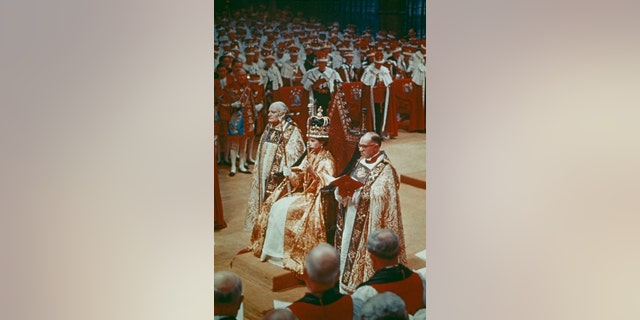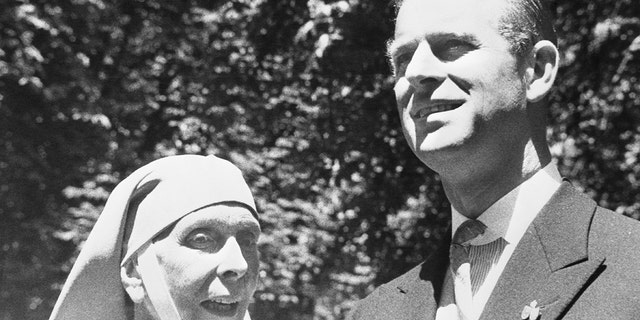The holy anointing oil that will be used during the most important aspect of King Charles’ coronation will be animal cruelty-free.
The sacred chrism oil has been reformulated and won’t include waxy substances from the intestines of sperm whales or secretions from glands of small mammals like civets, the BBC reported. Instead, the mixture will consist of olive oil, rose, jasmine, cinnamon, orange blossom and sesame.
According to the outlet, the olives used for the royal oil are harvested from the burial site of the king’s grandmother, Princess Alice, who rests at the Mount of Olive’s Monastery of Mary Magdalene in Jerusalem. During the coronation, the king will be blessed with the oil as it touches his head, chest and hands.
“King Charles is known to be someone who cares deeply for the environment and nature, so it is no surprise that the oil used for his anointing has been prepared with maximum respect for animals and nature,” royal commentator and broadcaster Jonathan Sacerdoti told Fox News Digital.
KING CHARLES, CAMILLA TO BREAK ROYAL TRADITION AT CORONATION WITH ‘BOLD MOVE’: ‘AN ENORMOUS HONOR’
The holy oil that will be used at King Charles III’s coronation will consist of olive oil, rose, jasmine, cinnamon, orange blossom and sesame. (Max Mumby/Indigo/Getty Images)
“The palace has said the oil for the king’s coronation is based on a formula that has been used for hundreds of years,” Sacerdoti shared. “However, the recipe has also been modernized to ensure that no animals were harmed to create it. Previous versions contained civet oil, which is commonly used in perfumery. [It] has been left out of the recipe this time in respect of animal cruelty concerns.
“Another animal product that has also been left out is ambergris, a solid waxy substance originating in the intestine of the sperm whale,” Sacerdoti added. “In Eastern cultures, it has been used as a medicine or as a spice. And, in the west, it has been used to stabilize the scent of perfumes.
CLICK HERE TO SIGN UP FOR THE ENTERTAINMENT NEWSLETTER
“The creation of the oil was carried out at the Church of the Holy Sepulchre, believed by Christians to be Jesus’ burial place, and it was blessed in a ceremony led by the Patriarch of Jerusalem, Theophilos III, as well as by Anglican archbishop Hosam Naoum.”
Royal expert Hilary Fordwich told Fox News Digital that while each coronation is modified for the times, the oil has always remained sacred. Its original recipe dates back to the coronation of Charles I in 1626.

Queen Elizabeth II at her coronation ceremony at Westminster Abbey, London, circa 1953. The oil used for her coronation was made from musk deer, civet cat and sperm whale. (Hulton Archive/Getty Images)
“The oil is stored in a bottle and traditionally held in great secrecy by the Dean of Westminster at Westminster Abbey,” she said. “The anointing of a new monarch, the act of consecration, is so sacred it takes place privately under a canopy, transforming the moment into a deeply personal experience between only the sovereign and God.
“Camilla will also be anointed with holy oil and crowned.”
In February, it was confirmed the queen consort will not use the Koh-i-Noor diamond in her coronation crown. Rather than commission a new crown, as is customary, Camilla will modify Queen Mary’s crown using diamonds from Queen Elizabeth II’s personal collection, the palace said in a statement.
Some observers had speculated that the 75-year-old would wear the crown that was made for the queen mother in 1937, which had the Koh-i-Noor diamond as its centerpiece. That reportedly sparked concern from some people in India, who said using the Koh-i-Noor in the coronation could be an uncomfortable reminder of Britain’s oppressive past.

In February, it was confirmed that Camilla, the queen consort, will not to use the Koh-i-Noor diamond in her coronation crown. (Samir Hussein/WireImage)
Seized by the East India Company after its victory in the Second Anglo-Sikh War of 1849, the gem was given to Queen Victoria and has remained part of the crown jewels ever since. But countries including India, Pakistan, Iran and Afghanistan have all claimed ownership.
Christopher Andersen, author of “The King,” told Fox News Digital the decision to modify the sacred oil was “a predictably woke gesture.” However, if the king really wanted to make “a significant social statement,” he could give the Great Star of Africa back to South Africa.
KING CHARLES DENIED BY HARRY STYLES, ADELE, ELTON JOHN FOR CORONATION CONCERT: EXPERTS REVEAL WHY
“[It is] a fist-sized 500-carat diamond which sits cradled in the royal scepter,” Andersen explained. “The largest gem-quality cut diamond in the world, the Great Star of Africa was given to Edward VII by the colonial government of South Africa in 1907. It is regarded by many as a ‘blood diamond’ that was stolen. And since Queen Elizabeth’s death, there have been renewed demands that the royal family gives it back.
“Now, that would be a change in the coronation ceremony that would prove beyond a doubt that Charles intended to modernize the monarchy.”

Prince Philip, Duke of Edinburgh, husband of Britain’s Queen Elizabeth II, is shown in a reunion with his mother, Princess Alice of Greece. The olives used in King Charles’ coronation oil were grown on the Mount of Olives at the Monastery of Mary Magdalene, which is where his grandmother is buried. (Getty Images)
Still, the anointing of the monarch is a crucial element of the ceremony, Andersen noted, and one that will be carefully observed.
“The anointing of the monarch is rooted in the ancient and deeply-held spiritual conviction that kings and queens have been chosen by God,” he explained. “This is doubly true in Great Britain, where Charles will rule not only as king but as head of the Church of England.
“Some might view this sacrosanct aspect of the ceremony as a little disingenuous since Charles now becomes the first divorced man ever crowned king — and alongside the equally-divorced woman he cheated on his wife with, no less.”
The Associated Press contributed to this report.